What would children like to listen to?
tl;dr — here is a Spotify playlist 🙂 — https://open.spotify.com/playlist/4Co4rHHHk2J0v8026S7oKn?si=32ba1ff1834c41d9
“It’s no problem finding music for children”, the record companies say.
But what really works? What brings joy and engagement?
Even when I was only three years old, and using my father’s ex-WWII valve radio, the dials were crowded from end to end with countless styles of music.
On the long waves in southern England were French chansons, orchestral and chamber music also from across the English Channel, and a mixture of music from several decades on BBC Radio 2, labelled as “1500 metres, Droitwich”.
Medium Wave brought traditional Irish music from Dublin via Athlone, the measured tones of the new Radios 4 and 3, then broadcasting art music for everyone throughout much of the day, and the “exciting, fun sound of Radio 1”.
It was hearing Tony Blackburn launch the station in 1967, and head a presenting team enjoying the effect of pop music, that first made me want to be on the radio — which I still am, as a commercial radio newsreader.
Then, around the world on Short Wave, strange scales and languages from the Middle East, China, Japan, Vietnam, the four corners of Africa, and the Spanish-speaking orbit, arrived.
No, that’s avoiding the question.
The other day, my friend Julia shared a picture of her adorable infant granddaughter dancing to the wind ensemble of the London Philharmonic Orchestra during a free open-air show for villages near Glyndebourne: Glynde Oom-Pah Day. It’s a regular event where one of the two opera house pit bands come to play for fun, and to offer great music-making because it needs to be heard by everyone, without fuss.
Julia’s original question was: “Children’s music recommendations please!”
Here is a personal list, based on my memories of what I heard on the old radio, and my father building a record player for some classical LPs he’d collected.
It’s purely individual, because I’ve no background as a music teacher for children; only young adults.
A lot of compilations for children seem rather parent-oriented: they’re intended to help infants go to sleep! My selections are exactly the opposite.
Peter And The Wolf
Sergei Prokofiev’s half-hour masterpiece for children was one side of a favourite LP released in 1964, the year I was born. The record label, ‘Fidelio’, was known for recycling low-price library music tapes, so the players, credited as “Colonne Orchestra under Isaie Disenhaus” were probably some college orchestra, or eastern European radio ensemble, recording at midnight for the session fee alone. Certainly, the same recording on another, related, label has the players with a different credit “the Pasdeloup Orchestra”, which is a genuine ensemble.
Update: the conductor appears to be a real musician (1924-2006), and was also the composer of some film music (for Robert Bresson) and choral works.
However, the narrator is a real treat. Oda Slobodskaya‘s speaking sounds like it was recorded in a broom cupboard in Acton, then crudely spliced on tape between the orchestral performances. Ms. Slobodskaya (1888–1970) was a soprano, born in Vilnius when it was part of the Russian Empire, who later moved to London to become a British citizen. Her song recordings are treasured, with one writer adding she possessed a “beautiful and ample voice of characteristically Slavonic colour”, with a “strongly accented speaking voice and a characterful turn of phrase”.
Her Peter and the Wolf amply displays this and, above all, is my best remembered childhood record. But it won’t be to everyone’s liking.
Here is a recording of the LP.
A particularly charming video production is this recent arrangement for wind quintet and percussion, which my friend’s granddaughter has been thoroughly interacting with lately. It was recorded remotely, during lockdown.
Many audio recordings with familiar voices are available. On a computer editing system, it’s really easy to make your own by pulling apart your own favourite orchestral performance, and adding your own narration, simply recorded.
David Bowie? Sure.
Peter Ustinov? No problem.
Sting? Well, he was a proper teacher before becoming a music legend. You’ll need to start on Track 2.
Dame Edna Everage? Here you are, possums.
Jupiter from The Planets
The exciting fourth movement from Gustav Holst’s perennially popular suite The Planets ended Side 1 on the first classical LP I ever asked my parents to buy.
Jupiter, The Bringer Of Jollity not only brings plenty of danceable, child-friendly rhythms into the work as a whole, but also adds melodies that embed themselves quickly into many listeners’ memories. Two of the tunes have become hits in their own right: the “big tune” is the hymn I Vow to Thee my Country, sometimes suggested as an alternative national anthem for the UK, and its second main melody is the source of the Manfred Mann song Joybringer.
The LP at home was an idiosyncratic and rather punchy performance on what sounded like a film scoring stage by the Los Angeles Philharmonic Orchestra, conducted in 1958 by Leopold Stokowsky: no stranger to doing things his own way.
At school, in morning assembly, the teachers would sometimes play a record of the steadier interpretation by Adrian Boult. But it was the American recording that came first to me, and still brings more joy even in this era of authentic performances.
The Nutcracker Suite
I sometimes explain rhythm by saying that “before music, there was dance”.
And that’s why dance is so fundamental to children’s upbringing; something that the old BBC schools’ radio series “Music and Movement” broadcast about.
My father’s LPs of ballet suites by Tchaikovsky brought to me lashings of orchestral colours and rhythms, and instilled a love for Russian art music that’s lasted forever.
He didn’t explain much about the stories, but the music was immediately attractive. Here are some of the extracts I remember wearing out on the LP player in the late 1960s.
Overture: lively, and whispers of history, saying “Once upon a time…”
March: plainly danceable rhythm!
Trepak: the lively Russian dance.
Much more of this suite entered my circle of favourites later in life, but those are the principal sections I recall from before achieving school age. No wonder Disney’s studios thought it suitable for the animated interpretation in Fantasia in 1940.
Here’s the extract from the full movie. You might need to unmute your browser’s player.
Fantasie in E flat
This piece for pipe organ isn’t loud or grand — to start with. But its strange sounds, in a giant concert hall, captured my mind in childhood. And what’s below is the original recording that was on LP in my house; made in 1969, lately transferred to digital formats.
It’s hearing records such as this that convinced me to try playing pipe organ, which I still do when people need a last-minute stand-in for nights of horror in local churches.
Saint-Saens’ little Fantasie was the composer’s first published work for organ, and it comes from 1857, when he was 22. I have since heard the very instrument for which this was written in Paris (Saint-Sulpice), though this performance is on the Royal Albert Hall organ.
If you’d like to explore more of what was possible on the Royal Albert Hall organ in 1969, a whole string of recordings is here.
Ging heut’ morgen
My father’s taste in rather wobbly light opera singing didn’t agree with my childhood hearing: but one recording was different from them all.
Dame Janet Baker’s work cropped-up in a stereo demonstration LP put together for EMI in 1968 by a fellow who later became my lecturer: John Borwick. There was an enthusiasm for music to show off my Dad’s expertise in putting together audio systems, and this piece by Gustav Mahler not only did so admirably, but it was immensely attractive to a child.
The voice is pure, the tune frighteningly catchy, the orchestration full of colour but never overdone, and the rhythm rather springy as the singer declaims the morning greetings of the ‘merry finch’, the harebell and the ‘gleaming’ sun.
The lyrics themselves take a sad twist at the very end, but Mahler transforms this through music into an atmosphere of hope. Aged four, I didn’t understand this at all, of course.
The Eroica symphony
From the same LP came the third movement of Beethoven’s Symphony No. 3, the Eroica (‘heroic’).
Like many of symphonic third movements from Beethoven’s time onwards, this was a transformation of the stately, customary, ‘minuet and trio’ into a much livelier dance form, usually given the Italian title ‘scherzo’, meaning ‘a joke’, or ‘playful’.
And it was! In just under six minutes, we get an orchestra gamely chugging away at an incredible pace, an exciting trio of French horns, some syncopated rhythms, and lots of dynamics.
More than fifty years after that recording, some people play it even faster!
Carnival of the Animals
So often, ‘music for children’ means ‘music grown-ups think is about children’.
But the pieces in this suite not only contain lively rhythms, memorable tunes, and are mostly very short; but also thrill the child in every adult.
Yes, more Saint-Saens: this time the suite that, for a while, he wanted hidden. Yet Carnival of the Animals seems to concentrate, in one group of pieces, more memorable melodies per minute than almost anything else. And all enunciated by glass-clear arrangement, and the sharp points of light made possible by adding a pair of pianos to the small orchestra.
Saint-Saens was reportedly afraid this suite would harm his ‘serious’ reputation, but he also wrote at the time that composing it was “such fun”. Unfortunately, apart from a few private performances, it was never heard again until after he died.
Somehow, each animal appears represented in the music; including the two pianists. Kangaroos hop, hens cluck, fish in the aquarium shimmer in the light, and nothing can match the grace of The Swan (which dancer Anna Pavlova took to the world). As for the “characters with long ears”, are they donkeys? Or are the music critics?
I can’t overstate how deeply this little set of pieces goes into me.
The suite starts this complete programme of French children’s music, performed by the LSO in 1989.
Mock Morris
Confession time: this is a life-long earworm.
Percy Grainger’s arrangements of English folk songs are legion, the best-known being “In an English Country Garden“.
But the first I ever knew was “Mock Morris”. Here in Lewes, we’re blessed with frequent visits from Morris sides; one of which danced for the birthday of folk legend Shirley Collins outside her house in the town only a few weeks ago.
The piece, composed for solo piano in 1910, later arranged (or ‘dished-up’ as Grainger would put it) for many other ensembles, was always lively to dance to; and conjured up a lost image of peaceful, harmonious rural England that could never return, where children grew up innocently, where clothes were white and clean, and where the harvest always came home.
Of course, that never happened. Several important people in the English folk music revival were among the millions killed in wars, women were utterly suppressed, children were abused, starvation and deadly disease were rife, and illiteracy was the rule.
But, from his home in Australia, Grainger still found light. Here’s his piano original.
And this is the ear-worm for me: Martin Jones’ solo in the orchestral version that finishes the film Howard’s End.
Did you forget Kabalevsky? Zoltan Kodaly? Chopin’s Mazurkas and waltzes?
No — but they’re for next time, and there are a couple of examples on the Spotify playlist.
I hope D., R., Julia, and children everywhere, at any age, find something to enjoy here.

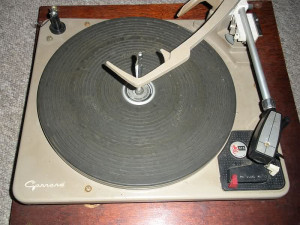 , the autochanger based on the SP25, into a polished brown radiogram cabinet and wired the crystal cartridge to the input of the built-in valve radio/amplifier. The cabinet had a richly toned single speaker underneath, and this system of glowing radio dial and filaments played his classical LPs, the 7-inch singles my mother inherited from her DJ brother, and my children’s records, together with some shellac 78s from second-hand shops and relatives, played by
, the autochanger based on the SP25, into a polished brown radiogram cabinet and wired the crystal cartridge to the input of the built-in valve radio/amplifier. The cabinet had a richly toned single speaker underneath, and this system of glowing radio dial and filaments played his classical LPs, the 7-inch singles my mother inherited from her DJ brother, and my children’s records, together with some shellac 78s from second-hand shops and relatives, played by 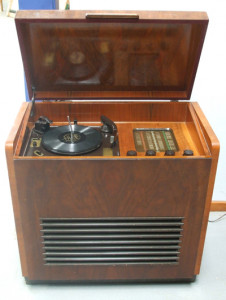 and speech recordings too from companies like
and speech recordings too from companies like 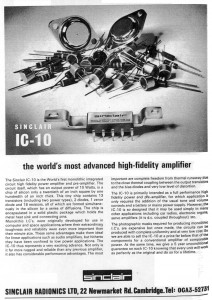 replaced in 1969 by a black box into which my father had installed a Sinclair IC10-based 10W amp, which lasted through the replacement of the cartridge with a ceramic item in 1971, then he built (with me holding the circuit-boards steady sometimes) the Practical Electronics Gemini stereo amp set in 1972. In the years of mass-market stereo LPs on “
replaced in 1969 by a black box into which my father had installed a Sinclair IC10-based 10W amp, which lasted through the replacement of the cartridge with a ceramic item in 1971, then he built (with me holding the circuit-boards steady sometimes) the Practical Electronics Gemini stereo amp set in 1972. In the years of mass-market stereo LPs on “ “But it was a stereo hi-fi to US” (to misquote Eric Idle), and the leap forward into “sound sculpted in space” was never regretted.
“But it was a stereo hi-fi to US” (to misquote Eric Idle), and the leap forward into “sound sculpted in space” was never regretted.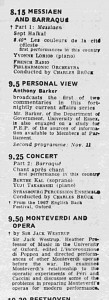 them on the Radio 3 concerts. Sometimes the pitch wavered slowly. Nearly always the sound had a ‘fuzz’ with it toward the end of a side, particularly on French horns, muted brass and sopranos. None of this happened when I taped a cassette off the radio, and it was a crying shame that all recorded music for the masses had this gauze of dirt, this veil in front of it. I learned where every scratch was in the quiet passages of the symphonies and chamber music on the shelf, and was almost surprised when those noises didn’t occur where expected on radio performances. My parents didn’t mind the interruptions, but I knew this rubbish was not music, even though the frequency response ran smoothly from bottom to top and the amplifier’s distortion was almost below measurement. And it was sad that one poorly set-up pickup or arm could damage a precious recording for ever.
them on the Radio 3 concerts. Sometimes the pitch wavered slowly. Nearly always the sound had a ‘fuzz’ with it toward the end of a side, particularly on French horns, muted brass and sopranos. None of this happened when I taped a cassette off the radio, and it was a crying shame that all recorded music for the masses had this gauze of dirt, this veil in front of it. I learned where every scratch was in the quiet passages of the symphonies and chamber music on the shelf, and was almost surprised when those noises didn’t occur where expected on radio performances. My parents didn’t mind the interruptions, but I knew this rubbish was not music, even though the frequency response ran smoothly from bottom to top and the amplifier’s distortion was almost below measurement. And it was sad that one poorly set-up pickup or arm could damage a precious recording for ever.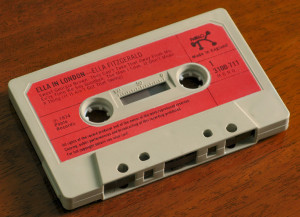 “Musicassettes” too often sounded muddy, though we rescued a reel-to-reel deck to play home-recorded tapes well; but no decent tapes were available unless recorded from Radio 3 concerts or the
“Musicassettes” too often sounded muddy, though we rescued a reel-to-reel deck to play home-recorded tapes well; but no decent tapes were available unless recorded from Radio 3 concerts or the 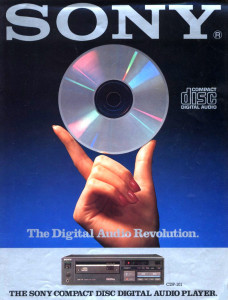 the CD came along. Teenagers (as I was then) can tell where 20kHz brickwall filters harm music, but at last, at long last, the music was almost completely pure. It did not waver or wobble. It was not interrupted by ticks and pops, nor by fuzz. Its quality was identical from beginning to end. There was no mourning that the beautiful passages of “
the CD came along. Teenagers (as I was then) can tell where 20kHz brickwall filters harm music, but at last, at long last, the music was almost completely pure. It did not waver or wobble. It was not interrupted by ticks and pops, nor by fuzz. Its quality was identical from beginning to end. There was no mourning that the beautiful passages of “